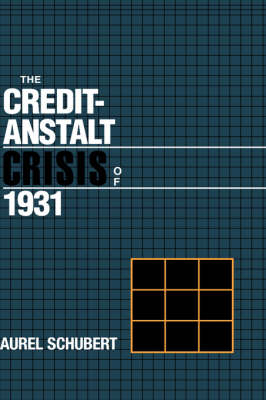
The Credit-Anstalt Crisis of 1931
Seiten
1992
Cambridge University Press (Verlag)
978-0-521-36537-6 (ISBN)
Cambridge University Press (Verlag)
978-0-521-36537-6 (ISBN)
Shubert analyses the impact of the Austrian 1931 financial crisis on Europe and the Great Depression, by analysing it using theories of financial crises, identifying the causes of the crisis, and examining the market's efficiency in predicting events. He also analyses how the crisis was transmitted to the real sector, and studies the behaviour of the Austrian as well as international authorities.
Austria played a prominent role in the worldwide events of 1931 as the largest bank in Central and Eastern Europe, the Viennese Credit-Anstalt, collapsed and led Europe into a financial panic that spread to other parts of the world. The events in Austria were pivotal to the economic developments of the 1930s, yet the literature about them has been sparse. In this book, Schubert analyses the crisis using theories of financial crises, identifies the causes of the crisis, examines the market's efficiency in predicting events, analyses how the crisis was transmitted to the real sector, and studies the behaviour of the Austrian as well as international authorities as lenders of last resort. His main conclusion is that even decades after the crisis, many of its lessons are still valid. Managerial and regulatory deficiencies led to the collapse of the bank; the subsequent currency crisis was not an irrational and unexplainable panic by a confused public, but rather a rational response to inconsistencies in policy; and the reactions of the largely unprepared authorities - in Austria as well as abroad - did not help to resolve the crisis quickly.
Austria played a prominent role in the worldwide events of 1931 as the largest bank in Central and Eastern Europe, the Viennese Credit-Anstalt, collapsed and led Europe into a financial panic that spread to other parts of the world. The events in Austria were pivotal to the economic developments of the 1930s, yet the literature about them has been sparse. In this book, Schubert analyses the crisis using theories of financial crises, identifies the causes of the crisis, examines the market's efficiency in predicting events, analyses how the crisis was transmitted to the real sector, and studies the behaviour of the Austrian as well as international authorities as lenders of last resort. His main conclusion is that even decades after the crisis, many of its lessons are still valid. Managerial and regulatory deficiencies led to the collapse of the bank; the subsequent currency crisis was not an irrational and unexplainable panic by a confused public, but rather a rational response to inconsistencies in policy; and the reactions of the largely unprepared authorities - in Austria as well as abroad - did not help to resolve the crisis quickly.
Tables; Preface; 1. Introduction; 2. Diary of the crisis; 3. Financial crisis theories and the Austrian Experience of 1931; 4. The causes of the financial crisis; 5. The financial crisis and market efficiency; 6. The financial crisis and economic activity; 7 The financial crisis and the lender of last resort; 8. Alternative policies and policy implications; 9. Conclusions; Bibliography; Index.
| Erscheint lt. Verlag | 31.1.1992 |
|---|---|
| Reihe/Serie | Studies in Macroeconomic History |
| Verlagsort | Cambridge |
| Sprache | englisch |
| Maße | 158 x 236 mm |
| Gewicht | 465 g |
| Themenwelt | Geschichte ► Teilgebiete der Geschichte ► Wirtschaftsgeschichte |
| Wirtschaft ► Betriebswirtschaft / Management ► Finanzierung | |
| Betriebswirtschaft / Management ► Spezielle Betriebswirtschaftslehre ► Bankbetriebslehre | |
| ISBN-10 | 0-521-36537-6 / 0521365376 |
| ISBN-13 | 978-0-521-36537-6 / 9780521365376 |
| Zustand | Neuware |
| Haben Sie eine Frage zum Produkt? |
Mehr entdecken
aus dem Bereich
aus dem Bereich
die Ukraine, Polen und der Irrweg in der russischen Geschichte
Buch | Hardcover (2023)
C.H.Beck (Verlag)
CHF 39,20


